[DSP] W08 - Receiver Design
contents
- signal picks up noise while propagating in the channel
- it also get distorted as the channel acts as some sort of filter,
- that is not necessary lowpass or linear-phase
- interference occurs as well
-
there might be parts of the channel that might assumed to be usable and actually not
- the receiver has to deal with a copy of the transmitted signal
- very far from the idealized version used in the math for designing the transmitter
- adaptive filtering techniques enable digital receivers to cope with the distortions and the noise introduced by the channel
- topics: advanced signal processing classes
- this is an overview
- your ADSL receiver for instance
- allows high data rates
receiver design
- following is the sound made by a dial-up internet modem
- when connecting to the internet
- for graphical analysis of this sound, refer to receiver schematic below
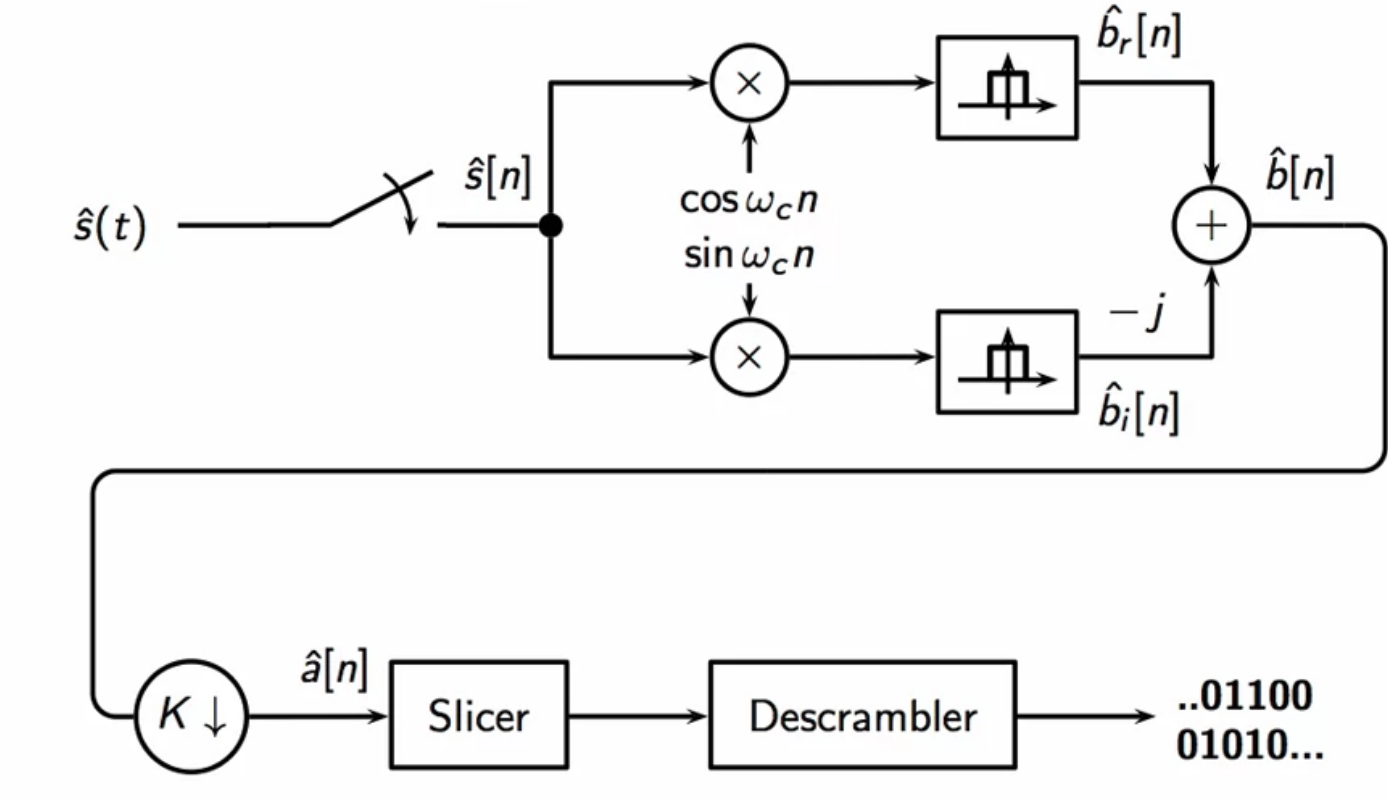
fig: QAM receiver signal flow schematic
- baseband complex samples are plotted on the complex plane
- if the input at the receiver is a signal
- the obtained baseband for this is
- so they point on the unit circle on the argand plane
- the angle between successive points will be
pilot tones
- the receiver sends pilot tones
- pilot tones are simple sinusoids used to probe the channel
- channel probing
-
used to gauge the response at particular frequencies
- some components
- many sinusoids
- which have abrupt phase changes
- phase reversals are used as time markers
- to estimate propagation delay of channel
- training sequence
- known sequence is sent my transmitter
- the receiver uses channel response to this known sequence to train an equalizer to offset channel effects
- handshake procedure between transmitter and receiver
- just before core information transmission begins
- low bitrate QAM transmission using only four points
- 2 bits per symbol
- parameters exchange of speed, constellation size etc
- since only 4 points constellation,
- so even in noisy conditions ensure vital information exchange
- data transmission proper
- many sinusoids
receiver function
- challenges faced at the receiver and measures taken to offset each challenge
- interference
- handshake and line probing
- propagation delay
- delay estimation
- linear distortion
- adaptive equalization
- clock drifts between the receiver and the transmitter
- timing recovery
- advanced topic
- interference
main challenges
- challenge distortion
-
time-varying discrepancies in clocks
- the channel is approximated as a linear filter in the continuous-time domain to begin analysis
- : filter response
- the filter is assumed to introduce all distortion and delays
- signal at receiver end:
- delayed and distorted version of transmitted signal
- clock of transmitter:
- clock of receiver:
- no guarantee these two are synchronized

fig: DAC at transmitter and ADC at the receiver
delay compensation
- assuming the following are in sync
- clock of transmitter:
- clock of receiver:
- channel introduces a delay of seconds
- channel is a simple delay block
- we can write with and
- is the bulk delay
-
is the fractional delay
- bulk delay is simple to tackle
- also called the integer delay
- they are simply the delay that the channel adds to the signal
- this does not sift the peaks of the data with respect to the sampling interval
- discontinuities in pilot tones help figure out bulk delay
- impulses cannot be used as they are full band and get filtered out
- the fractional delay is more involved
- it shifts the peaks with respect to the sampling intervals
- interpolation is used to get the fractional delay compensation
- transmit
- receive
- after demodulation and bulk delay offset
- multiply by known frequency
- after offsetting bulk delay
- subsample values need to be computed
- in theory, compensate with a sinc fractional delay
- in practice use lagrange approximation
- practical application of lagrange polynomials
- lagrange approximation is around
- to compute with
- so, in summary
- estimate the delay
- compute the lagrangian coefficients
- filter with the resulting FIR
adaptive equalization
- measure to compensate for distortion
- let the channel distortion be
- is the equalizer compensation to offset channel distortion
- in theory
- but is not known
-
may change over time during transmission
- hence the equalization needs to adapt continuously
- following is the schematic of an adaptive equalizer
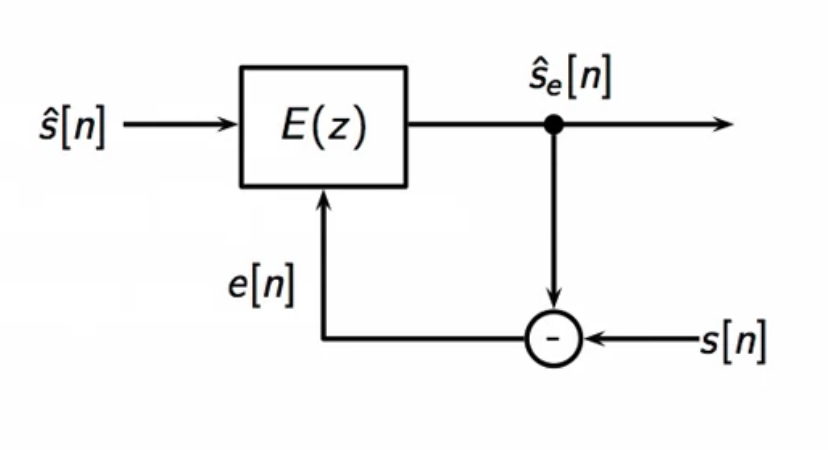
fig: core adaptive equalizer schematic
- the filter coefficient changes in time based on the error
- obtained from the output with the transmitted signal
- the exact signal is sent by the transmitter
- the receiver has the same copy to get the adaptive equalizer started
- this is a bootstrapping technique
- there are some symbols that are common to both the transmitter and receiver together
- this is called a training sequence
- handshake 4 point QAM
- the equalizer is initialized with this shared symbol set

fig: adaptive equalizer schematic in the big picture
- this process of bootstrapping is not error free
- but a generally good place to get started
- details of adaptive signal processing is an advanced topic
- needs more research, reading and understanding
adsl
- ADSL: asymmetric digital subscriber line
- adsl receives signals on a copper wire channel
- DSLAM: digital subscriber line access multiplier

fig: telephone network overview
- last mile: copper wire connecting the home modem to the exchange (CO - central office)
- copper wire has a large bandwidth
- POTS: plain old telephone system
- the (A)symmetry in the bandwidth is the A of the ADSL
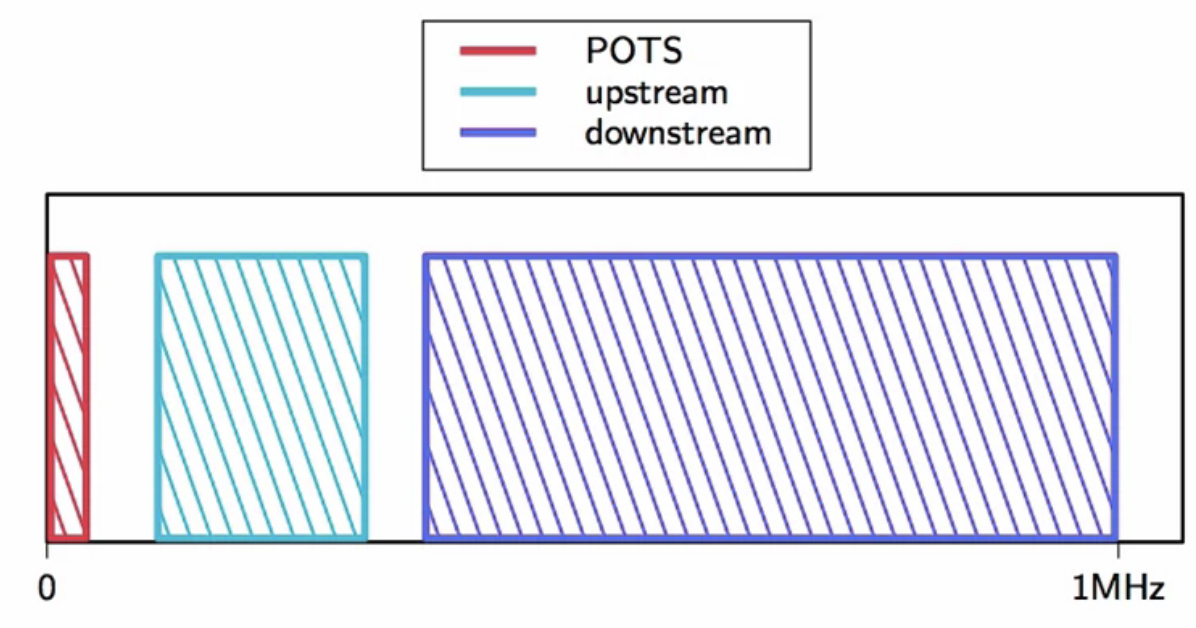
fig: adsl channel - copper wire bandwidth
channel propagation challenges
- attenuation: the uneven curve across the bandwidth
- physical wire imperfections
- parasitic capacitance
- electrical interference: large grey blog in a specific frequency region
- running the vacuum for instance raises the noise floor of the copper channel
- localized radio interference: the impulse at a specific frequency
- ship-to-shore communications: 0 - 100 kHz
- airplane communications: 100 - 500 kHz
- AM radio band: 500 kHz +
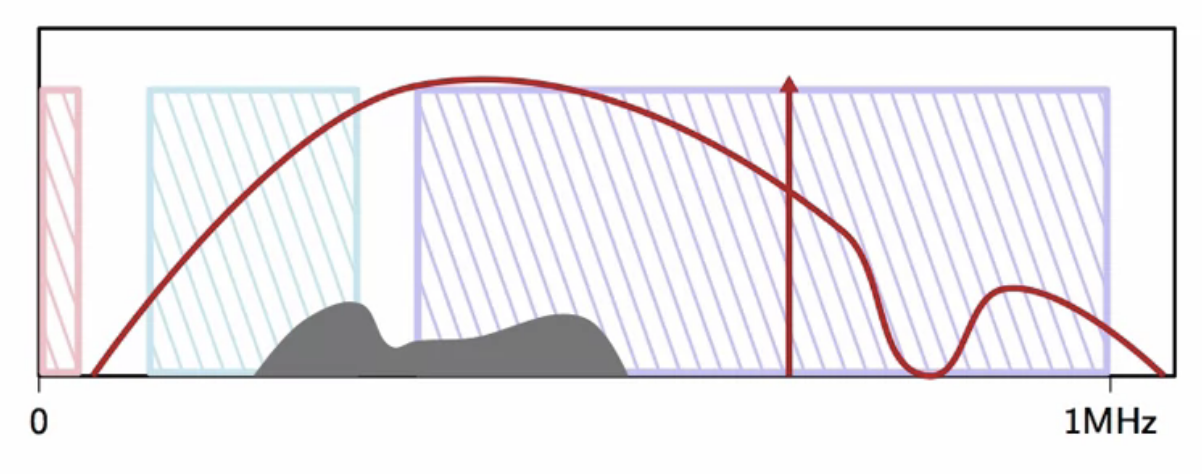
fig: adsl channel propagation challenges
- the channel is divided into independent sub-channels
- different channels are treated separately
- localized treatment in the receiver across all bands
- the cleanest channels are used to send maximum data
subchannel structure
- allocate N sub-channels over the total positive bandwidth
- equal sub-channel bandwidth
- equally spaced sub-channels with center frequency
digital design
- pick
- is high now
- center frequency for each subchannel
- bandwidth of each sub-channel
- to send symbols over a subchannel
- upsampling factor
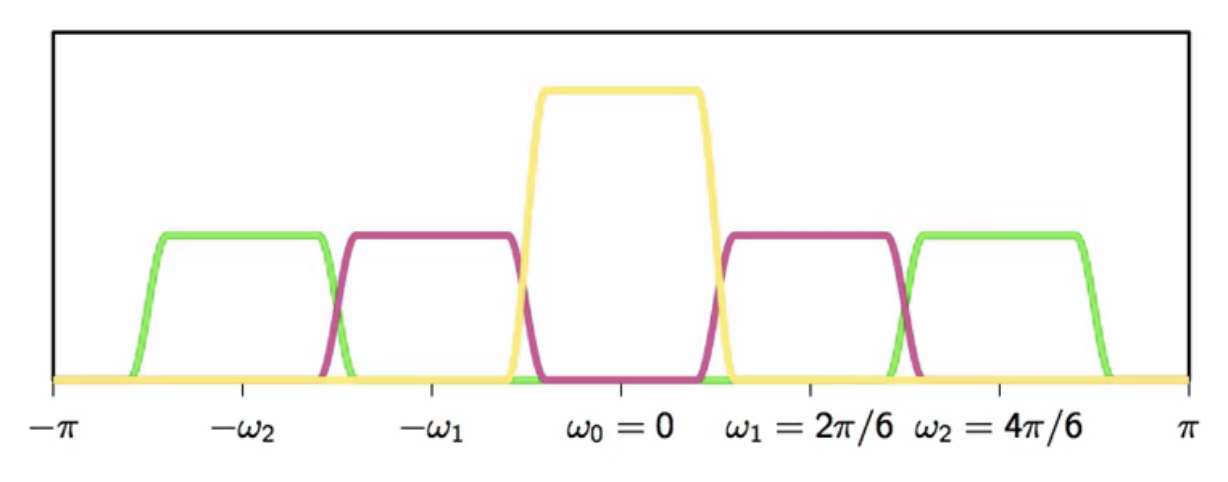
fig: subchannels of the adsl channel (N = 3)
- QAM modem is added on each channel
- decide on constellation size independently for each channel
- clean channel gets high numbered constellation
- noisy channel gets low numbered constellation
- noisy or forbidden sub-channels send zeros
- the structure of the communication scheme is sent to the receiver from the transmitter
- part of handshake procedure
- classic modulation scheme is applied in each channel as per below schematic
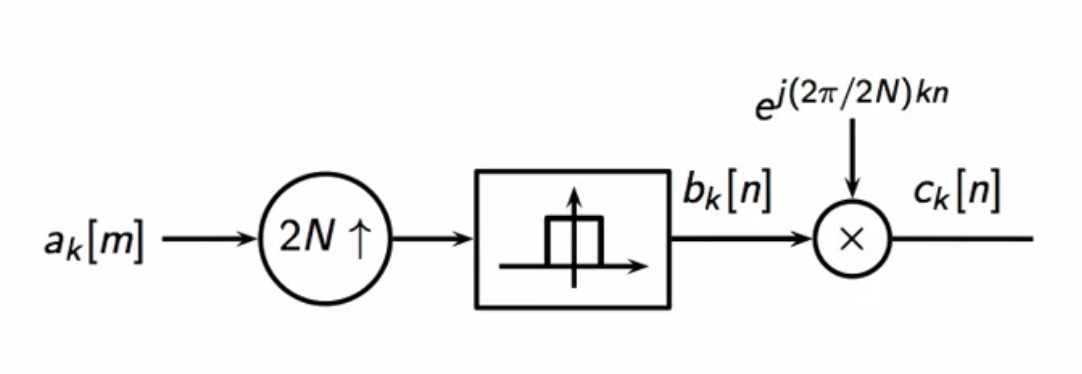
fig: modem on each sub-channel
- the receiver modem bank has several modems in parallel
- each channel has two unique attributes
- frequency of modulation
- mappers symbols series

fig: modem bank
discrete multitone modulation
- the modem banks maybe seen as oscillators whose output is summed to obtain a signal
- each oscillator is scaled with an amplitude
- and phase offset
- this bank is run for N samples to get the signal
- these are constant through the generation
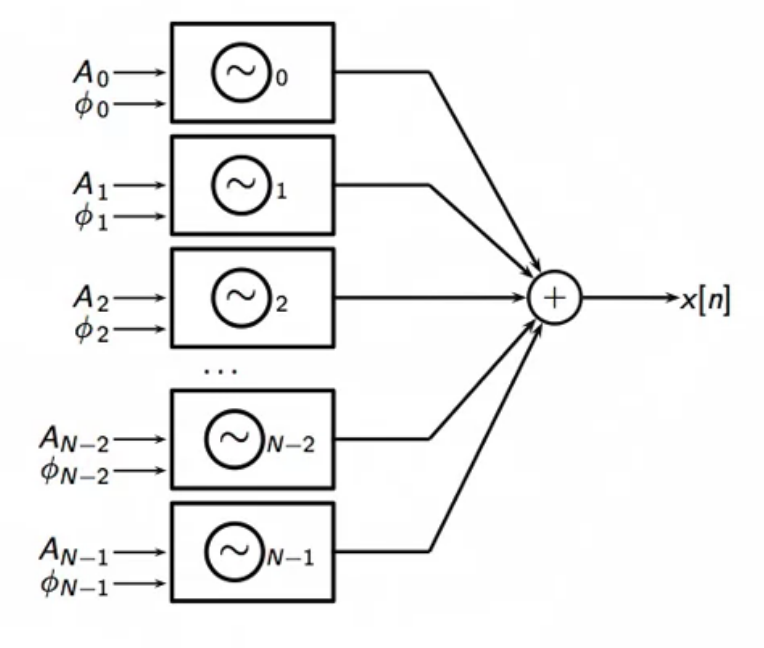
fig: oscillator bank paradigm for modem bank
- in the modem scenario, the amplitude and phase change at every sample
- they embed the complex symbol sequence
- with the discrete multitone modulation, adsl may be implemented with a simple inverse FFT
- provided that the symbols can be help constant during the whole upsampling event
- the modem structure can be mapped to the inverse DFT structure if this is done
- the ADSL trick:
- instead of using a god lowpass filter use a the 2N-tap interval indicator

fig: modem on each sub-channel
- oscillator in the modulator runs freely
- with simplification, in each chunk of 2N samples, the symbol is kept constant

fig: simplification of subchannel modem
- aggregate bandpass signal is calculated by

fig: simplified subchannels’ modem bank
- final goal: calculate
- hence, since baseband always has read valued symbols
ADSL schematic
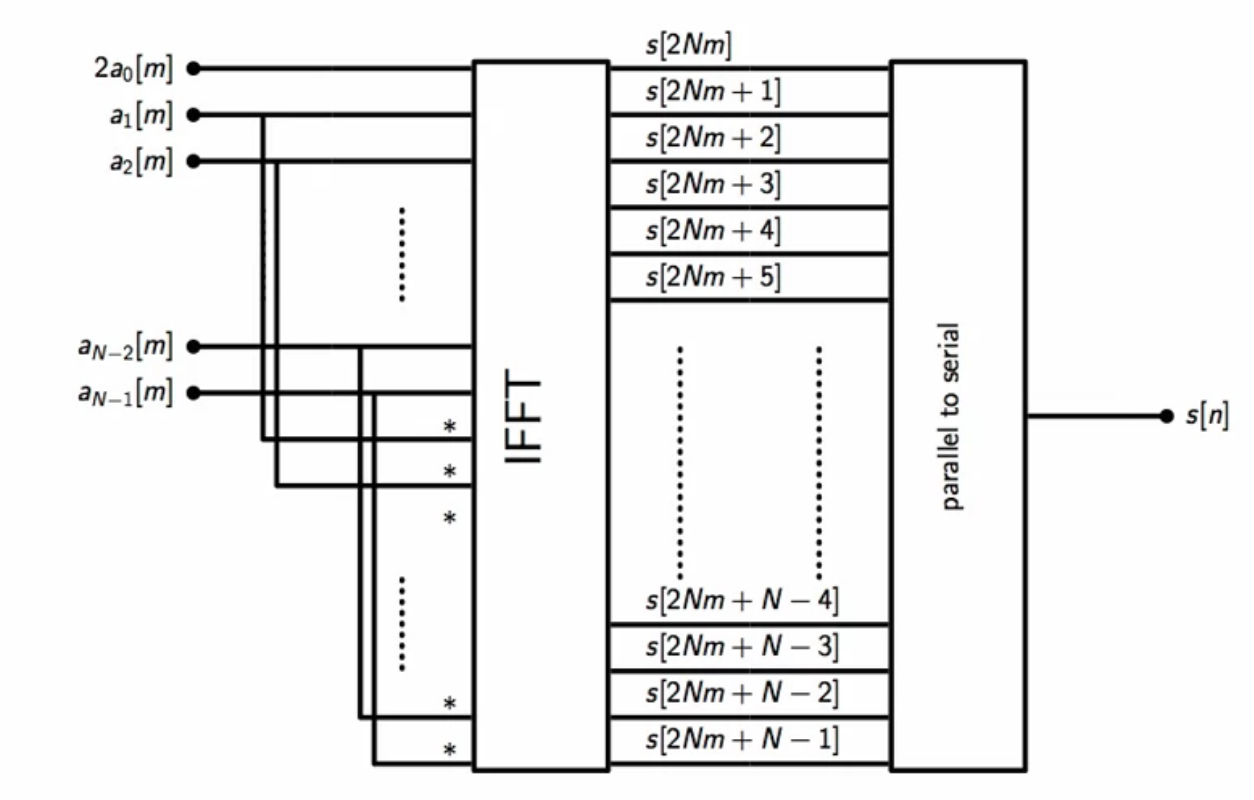
fig: simplified subchannels’ modem bank
ADSL specs
- N = 256
- each QAM can send 0 - 15 bit per symbol
- forbidden channels 0 to 7
- dedicated to voice
- channels 7 - 31: upstream data
- max theoretical throughput: 14.9 Mbps (downstream)